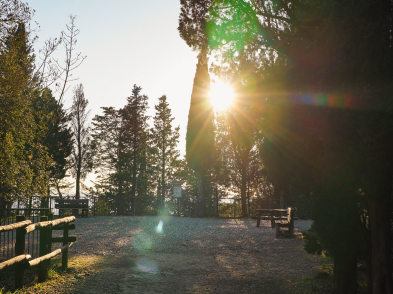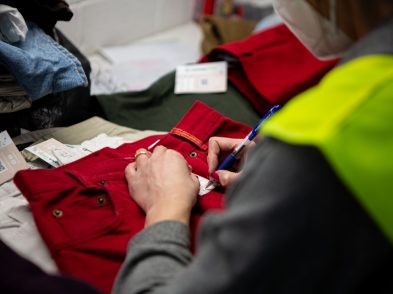During his eight years as director of the Fondazione Palazzo Strozzi, James Bradburne quite literally opened the doors of this Renaissance palace to the city, organizing 18 major exhibitions, opening the palazzo to contemporary art and creating a laboratory for research and creativity. The Florentine spoke with Dr. Bradburne about his accomplishments during his tenure at Palazzo Strozzi.
Alexandra Korey: Over the years, we’ve talked about so many things you’ve done here at Palazzo Strozzi, but what is the one thing you’re most proud of?
James Bradburne: Opening the doors. When I arrived in September 2006, the great portone of the Palazzo were closed, and the beautiful interior courtyard was bare—not a bench, flowerpot or a sign to show you the way to the exhibitions that were occasionally held there. By opening the doors and inviting people to see it as an extension of the city—an interior urban piazza—we signaled the Fondazione’s intention to put Palazzo Strozzi at the heart of the city and its cultural life. We started with concerts, dance and contemporary installations, and we have continued to ‘open doors’ in as many ways as possible—culturally, educationally, intellectually, socially and physically.
AK: Under your direction, Palazzo Strozzi has become an exemplar of best practice for museum education. In brief, how have you and your team innovated here?
JB: Inspired by years of collaboration with the schools of Reggio Emilia, we developed an approach called ‘visible listening,’ which involves inviting other, non-expert voices into the ‘sacred’ curated space of the exhibition and making them visible to all visitors. We have invited poets, children, teenagers, writers and musicians to write exhibition labels. We have invited visitors to leave their thoughts behind in the form of notes, drawings, postcards and sound recordings. In the penultimate exhibition, visitor comments were used as labels that were updated every few weeks.
This approach also takes the form of ‘listening’ to the exhibition content and developing the educational approach from the ‘bottom up,’ rather than imposing it from the ‘top down.’ This meant that the labels for the 2008 exhibition on Tang Dynasty China were based on interviews of Chinese museum visitors in Beijing about how they experienced ‘their’ objects. The 30s exhibition based its labeling on interviews with people who had grown up in the 1930s. In Art & Illusions we could trick all five senses—not only the eye—and the exhibition included olfactory illusions by Florence’s master perfumer Lorenzo Villoresi. The centrality of touch to The Springtime of the Renaissance led to Andrea Bocelli writing the introduction to the family and children’s catalogue.
AK: Tell us about the latest development in visitor interaction that you say is your ‘swan song’ in the Power and Pathos exhibit. How is this better than ‘digital games’ in the museum space, and what are your hopes for the outcome of this activity?
JB: Although we have used technology extensively since the outset, one of the challenges is to avoid it displacing or interfering with the experience of the real objects in the exhibition. This is why, even though we have interactive touch tables and touchscreens in the Palazzo, we have tended to use digital media more as a way to encourage visitors to visit the city before or after their visit to the Palazzo Strozzi. Our digital tools (including IOS and Android apps) include a digital version of every Palazzo Strozzi ‘passport,’ using geolocalization to take visitors to sites in the city associated with the exhibition, and to compare today’s reality with historical paintings and photos.
Within exhibitions, an interactive computer game that invited visitors to invest 5,000 virtual florins was an integral part of the Money & Beauty exhibition, but experience has shown that a hands-on mystery requiring the visitor to find clues in the exhibition itself gives a much more engaging experience. We first tried this in 2008: The Mystery of the Dead Impressionist galvanized an exploration of Impressionist masterpieces. In the current exhibition, my last, an interactive role-playing game The Mystery of the Missing Statue invites the visitor to win a trip to Athens by taking on the persona—and the thinking process—of an archaeologist, a collector or a forger in order to propose a solution to a riddle curators themselves have never solved: what statue stood on the empty base that is the exhibition’s first object?
In many ways, this is the culmination of a series of experiments conducted over the past eight years, and it is designed to see if this kind of ‘second reading’ of the exhibition creates an incentive for visitors to return more than once. If it succeeds in doing so, it will be more than merely a way to enhance an exhibition, it will show museums worldwide a possible way to entice visitors to re-visit their permanent collections, which are facing sharp drops in visits despite growth in overall museum attendance.
AK: How does an exhibition space—rather than a museum with a permanent collection—add value to a city like Florence?
JB: The mission of the Fondazione since its inception has been twofold: to bring an international approach to Florence, and to ‘give the Palazzo back to the city.’ The root of this mission was also twofold: to encourage repeat tourism by answering the question ‘why come back to Florence,’ and to show how to create the greatest possible value—of all kinds, not merely economic—with a relatively modest investment on the part of both public and private sectors.
The enormous value of an institution without a collection is that it can serve as a laboratory of potential ideas for permanent collections in Florence or beyond. Every six months, a new experiment can be conducted—how to attract new audiences, how to use new media, how to increase engagement. When we worked with Louvre education staff on The Springtime of the Renaissance, they were amazed to learn that we created totally new approaches for every exhibition. But it is never enough just to do—we have to learn, and share our results. In 2010 the Fondazione co-founded a master’s degree program in museum studies [with Marist College and Istituto Lorenzo de’ Medici in Florence]; as such, our exhibition research results in publications, papers, master’s theses and even doctorates.







